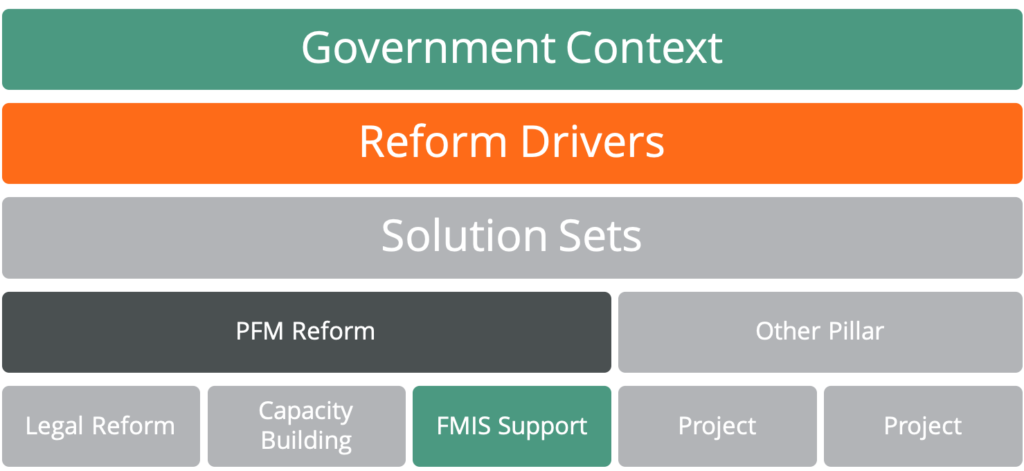Understand the FMIS Process and What Questions to Ask
This is the first in a series about improving government FMIS tenders:
- How to Improve FMIS Tenders
- Gateway Requirements for Effective FMIS Tenders
- Value for Money in FMIS Procurement
You might think that after 38 years of global proposals we might have learned a thing or two about government procurement processes.
We have.
We’ve also had public finance professionals in government, consultancies and donor organizations ask how these tender documents could improve to increase competition to lower prices, with better Value for Money (V4M). That’s because our exclusive Public Financial Management (PFM) focus includes procurement advisory services.
What is the FMIS Procurement Process?
Almost every piece of advice begins with “start with the end in mind”. Many government professionals believe that that’s what tenders do. Yet, very few do.
Why?
FMIS tenders result from complex strategic, tactical and administrative work. The process looks like this:

Government context: political, economic, environmental, social and cultural environment and problems in countries, regions, or municipalities
Reform drivers: compelling events, new government policies, examples of success elsewhere, civil society influencing, and opportunity for funding
Solutions sets: possible ways to reduce problems and leverage opportunities that can be expressed in annual budget documents, national development strategies, or partner country strategies
Pillars: pillars and targets aligned to solution sets
Public Financial Management reform: pillar to improve governance that is sometimes characterized as “cross-cutting” because general governance improvements supports implementation of other pillars, and is arranged in numerous projects
Legal reform project: statutory changes in key areas like financial management, treasury, procurement, public service, public investments, transparency, decentralization, assets and liabilities required to improve PFM
Capacity building project: training and mentoring of public servants on more advanced PFM concepts to take advantage of the reform
FMIS project: sets of public finance functions to be automated and improved to support PFM outcomes
Why the Focus on Features is Wrong
Many public finance professionals ask us about features. What features are needed? How do FreeBalance features compare with competitive offerings?
Features do not represent value.
Feature lists in tenders result from “solutioning”. It seems that many governments wish to guarantee comprehensiveness so they add as many features as possible.
What that means is that providers with excellent solutions are discouraged from bidding. And, these vendors are ranked lower in value to vendors who have many features but have poor success rates achieving government goals.
“Solutioning” is the process of identifying solution types and writing tenders based on these assumptions. Symptoms include:
- Mandating that the solutions must be custom-developer or Commercial-Off-The-Shelf (COTS) Enterprise Resource Planning (ERP)
- Imposition of how something must be done, rather than focusing what needs to be done
- Large feature sets, often impractical for the country context
- Insistence of “best practices” that are not relevant to the government context
- Emphasis on resumes and certifications rather than methodology and success rates
- Requiring in country knowledge, allowing vendors with private sector expertise but little public sector expertise to rank highly
- Generic objectives like efficiency, automation and transparency
- Unrealistic schedules
- Use of legacy enterprise software concepts like “modules” and acceptance of legacy rather than postmodern technologies
- Software stack requirements (.Net, Java, Oracle etc.)
Questions to Ask When Considering a FMIS Tender
The solutioning approach results in tenders that are not aligned with government objectives. The first quick fix is to explain how the FMIS will support government priorities (see next post on gateway requirements). Give vendors credit when they show how their approach will enable government objectives, even when those objectives are not spelled out in the tender.
Consider the questions that we ask ourselves when analyzing tenders, deciding whether to bid – and how to bid:
- Why specify ERP or custom-developed?
- Why support accrual accounting, Medium-Term Expenditure Frameworks (MTEF), program or performance budgeting?
- Is the government ready for advanced functionality?
- Why are current systems not integrated?
- Why hasn’t a Treasury Single Account (TSA) and international standards support not already been implemented?
- Why did it take so long to release the tender?
- What are the drivers behind the transparency requirements?
- Does the reform sequencing make sense?
- Does the selection of modules make sense in context?
- Why is the proposal very IT centric rather than PFM?
For more information on how FreeBalance delivers PFM reform please get in touch.